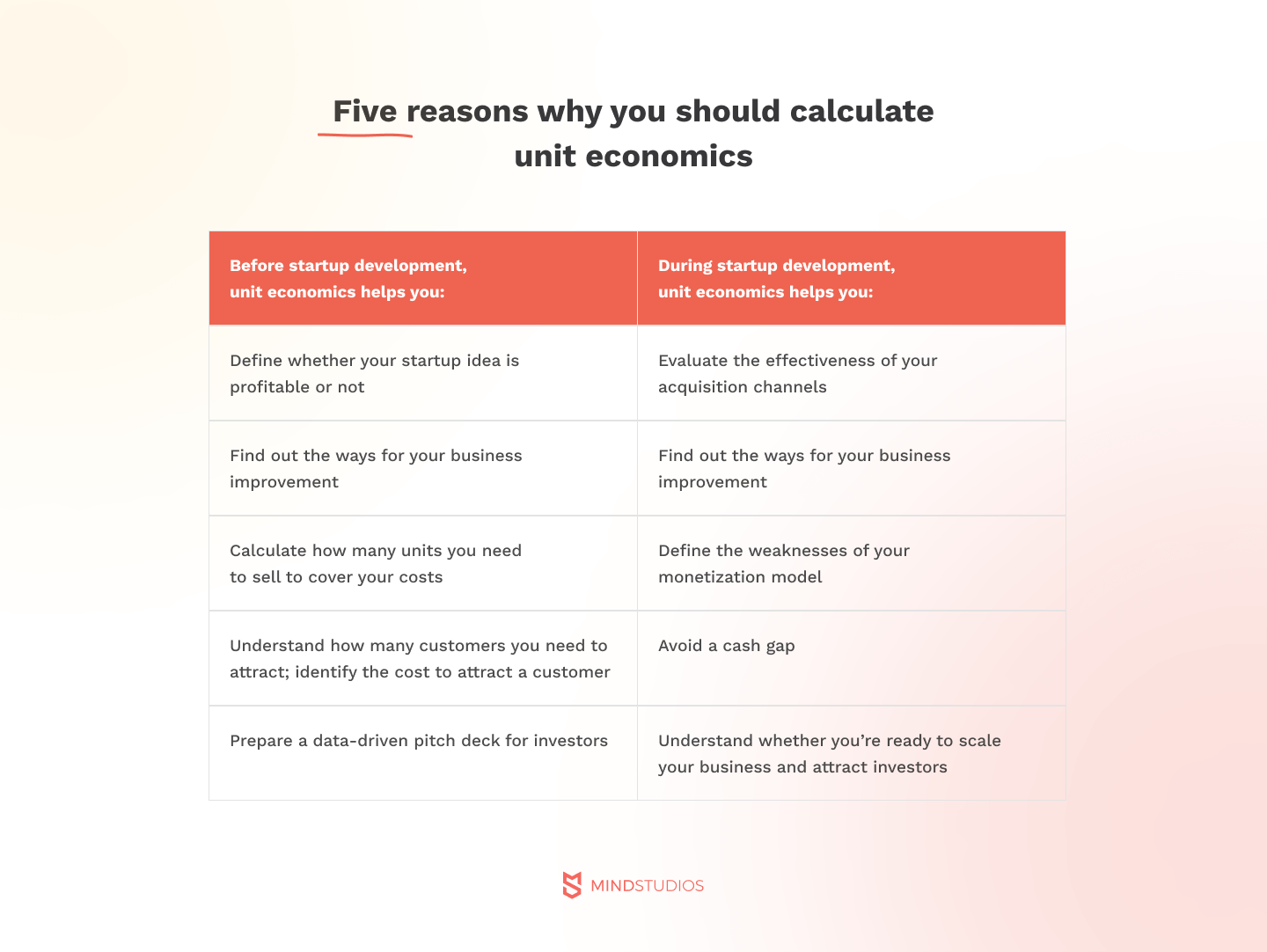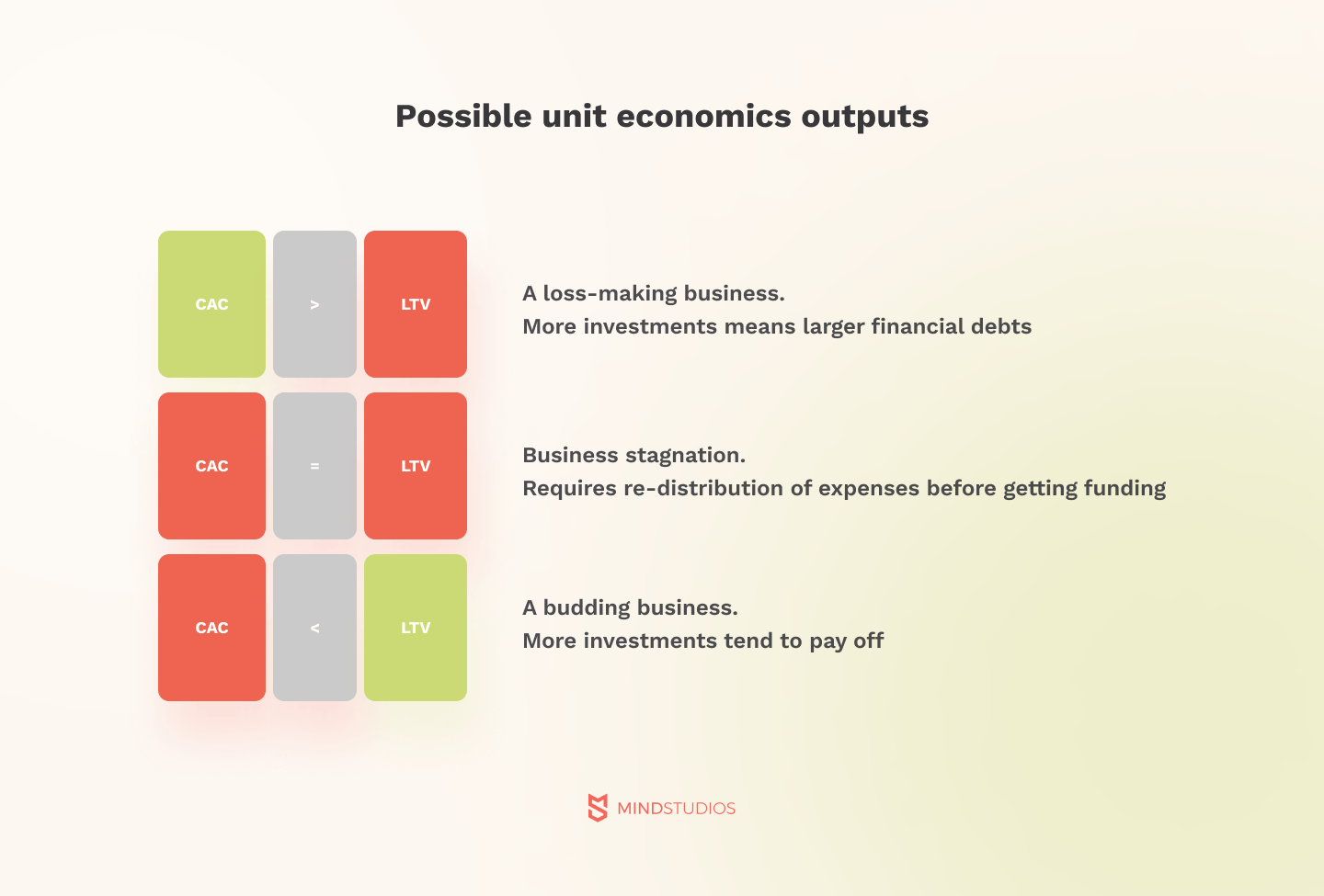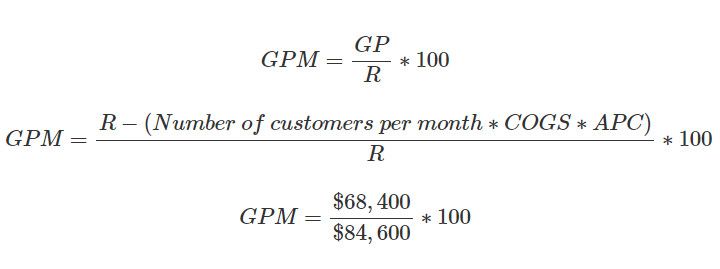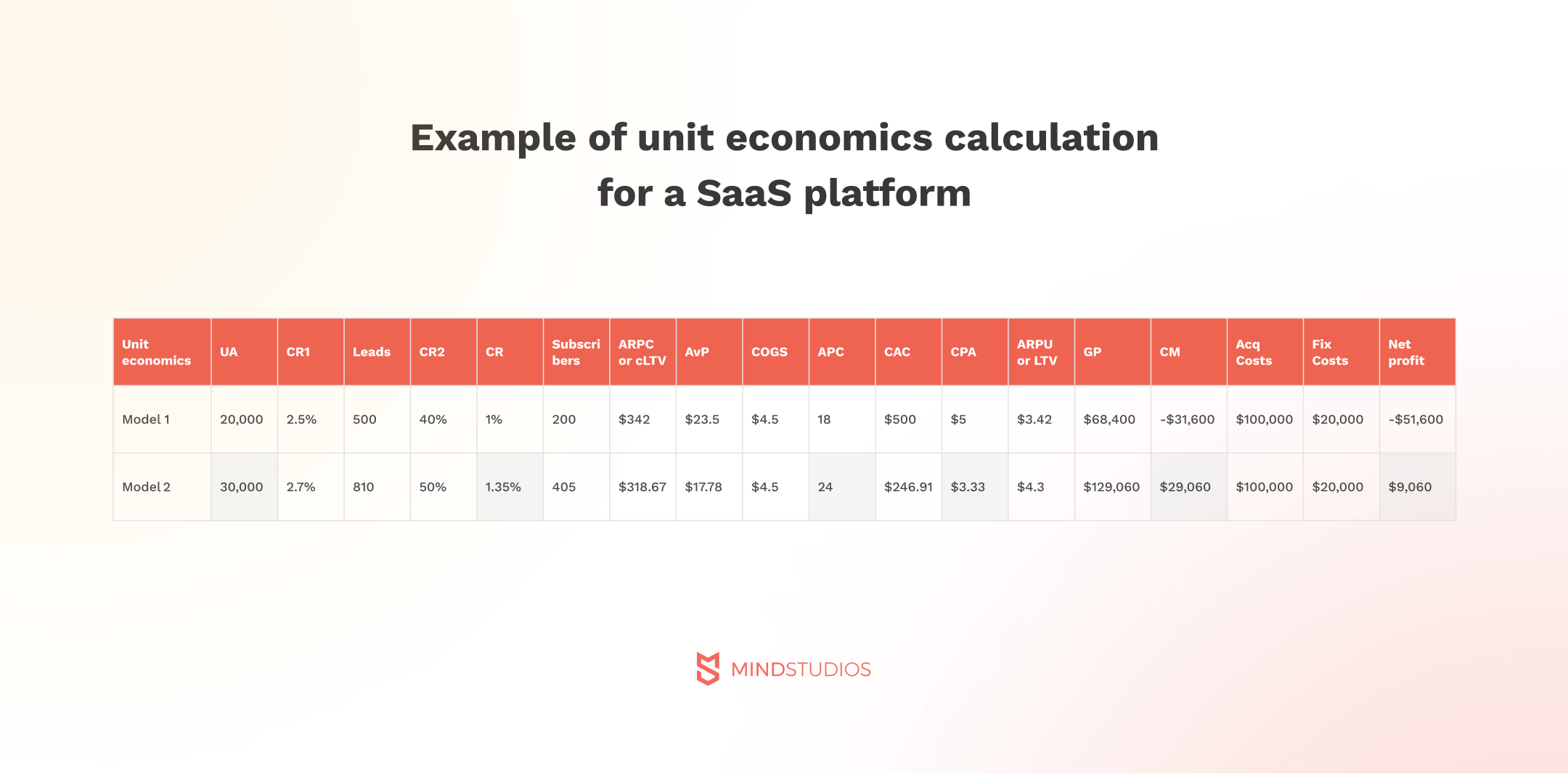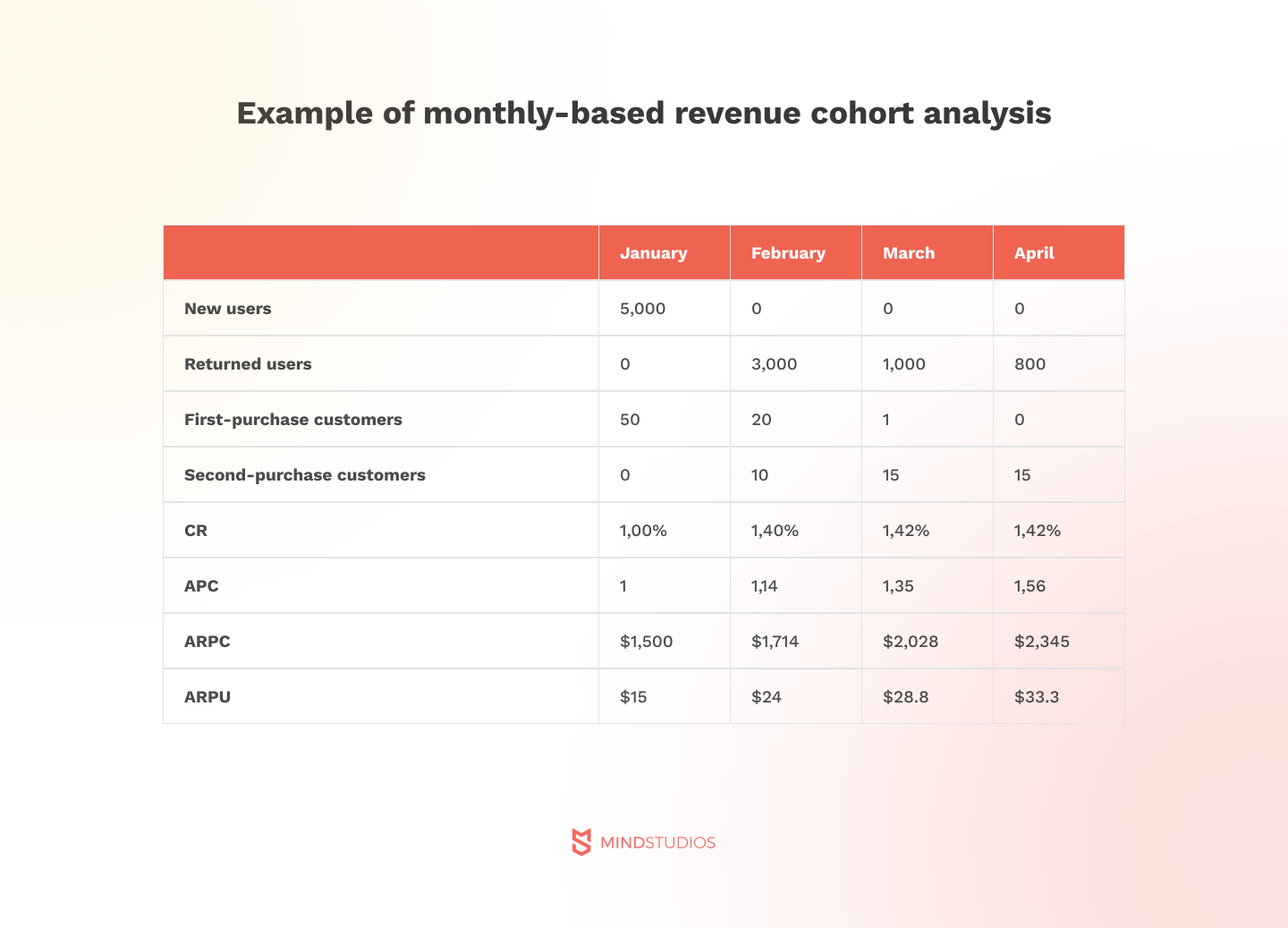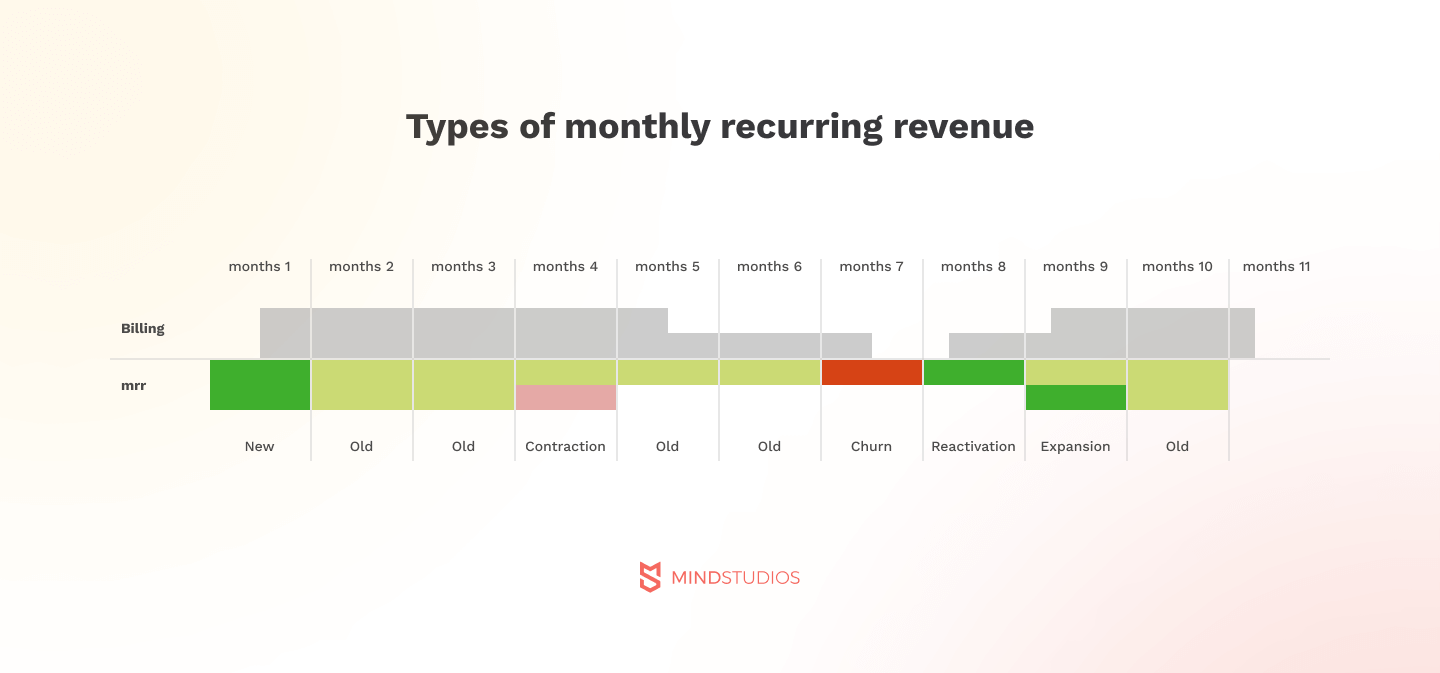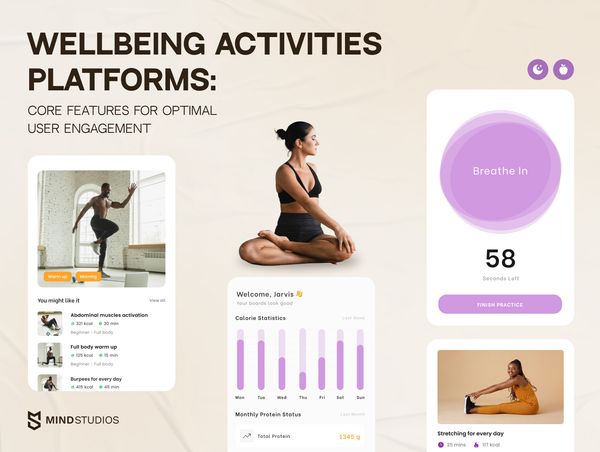
To keep afloat, every startup needs to be profitable. In theory, all you need to do is maximize the difference between the cost of production and the marketing costs for your product or service. In practice, just as you can’t reduce the cost of production to zero, you can’t endlessly increase your marketing costs because of competitors and the solvency of your target customers.
How to find the right balance between expenses and revenues that will make your business viable? There’s one possible answer — by calculating your unit economics.
Making unit economics clearer
The core of unit economics for startups is identifying whether you earn a profit or go into the red after you’ve sold a product unit and incurred all costs associated with that sale. First of all, let’s get to the bottom of the costs, then clarify what counts as a product unit.
What should you include in costs?
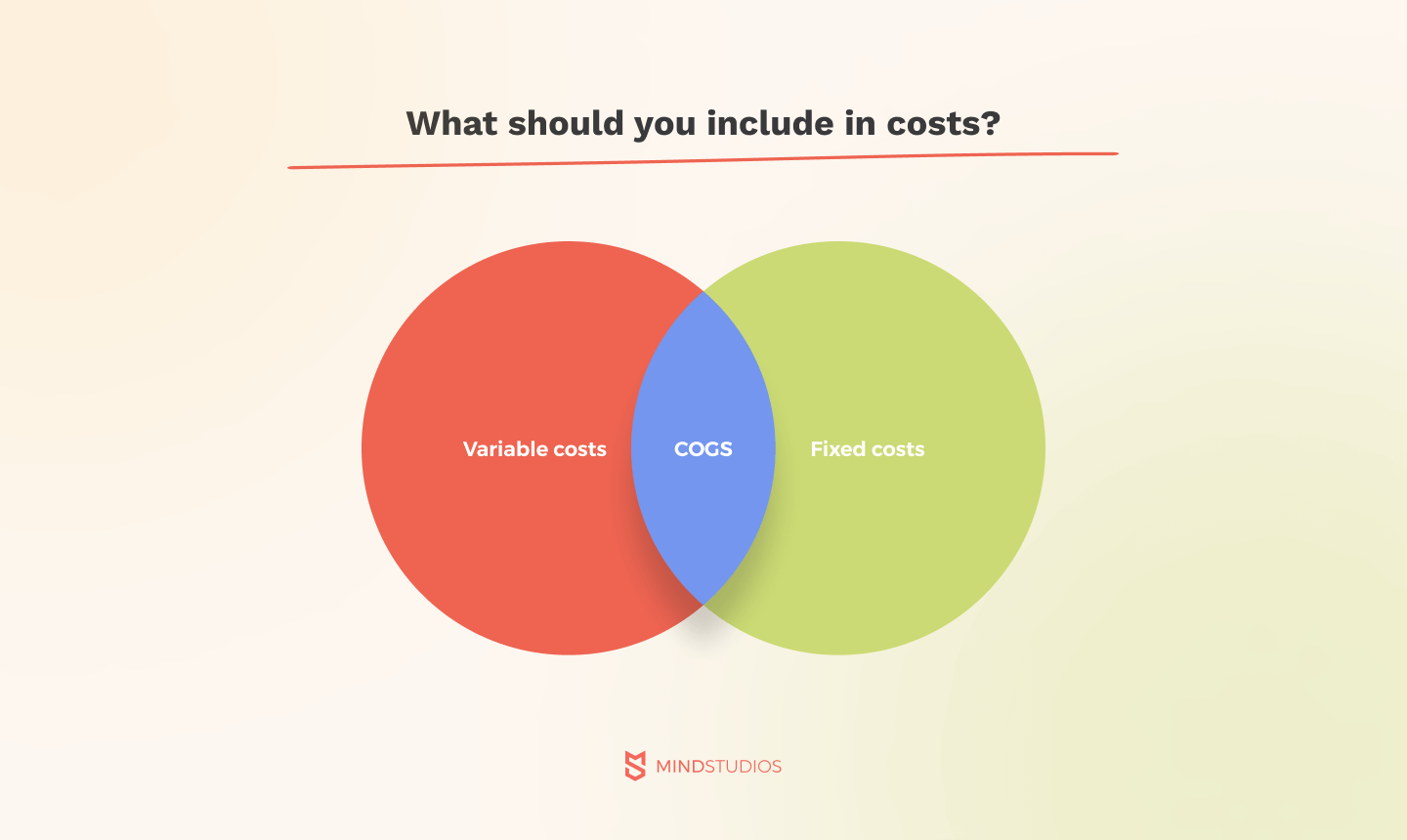
Variable costs are those which change according to production volume. The more product units you produce, the higher your variable costs, and vice versa. Variable costs include:
- Cost of raw materials for production
- Packaging costs
- Shipping costs
- Usage-based equipment depreciation
- Credit card fees on customer transactions
- Wages for labor, assuming they’re hourly
- Marketing campaigns
- Sales commissions
Unlike variable costs, fixed costs remain the same whether you produce something or not, so you can’t reduce or eliminate them. Examples of fixed costs include:
- Lease payments
- Rent payments
- Insurance
- Fixed salaries
- Employee benefits
- Utilities
- Payroll taxes
- Office supplies
Let’s highlight one more dimension of costs — the cost of goods sold (COGS). What falls under COGS are any expenses directly associated with production of your goods or services, whether they are variable or fixed. To understand how to calculate unit economics for your startup, you should have a clear picture of what to consider as your COGS. For a software as a service business, COGS can include:
- Hosting costs (costs for cloud computing services like AWS, Dropbox, and Google Drive)
- Costs for third-party APIs and SDKs embedded in your online constructor (payment gateways like Stripe or PayPal)
- Credit card fees on customer transactions (percentage of customer payments)
- Costs for website maintenance (managing data centers and servers)
- Costs for customer support (onboarding, consulting, data exporting, transaction assistance)
What counts as a product unit?

A unit is an element that generates measurable value for your business. Depending on what your business counts as a unit, you can approach unit economics calculation in two ways:
Approach #1. When a unit is one item sold
You can define a unit as one item sold if you have:
- An online shop in which one item sold is a physical good you’re selling
- A software as a service platform, where one item sold is a paid subscription (monthly, quarterly, annual, etc.)
- A B2C platform, where one item sold can be defined as one ride in a car, one order or one delivery (if you decide to make an on-demand food delivery app like Postmates)
To determine unit economics in this case, first of all, you need to calculate how much profit you can get after selling your goods or services — that is, you have to calculate your gross profit:

After getting your gross profit, you can figure out how profitable your business is by calculating the percentage of gross profit in your total sales — that is, by calculating your contribution margin:
Example. Say you’re going to sell porcelain cups via your website. The cost to produce one cup is $5: $2 for raw materials and $3 for the direct labor involved in producing one cup. Plus, you need to pay on average $2 for packaging and delivery and $1 for credit card transaction fees. Also, you need to spend on average $1 on marketing and sales efforts to sell one cup. Thus, your variable costs will be $9. You can sell cups for $15 each. In this case, your gross profit per cup will be $15 - $9 = $6. To calculate your net profit, you need to take into account your fixed costs. Assuming you incur monthly fixed costs of $3,000, which includes office rent, insurance, taxes, employee salaries, utilities, and technical maintenance and support for your website. In this case, your monthly profit will look like this:
| Number of cups sold | Total variable costs | Total fixed costs | Total costs | Total sales | Gross profit | Net profit |
|---|---|---|---|---|---|---|
| 50 cups | $450 | $3,000 | $3,450 | $750 | $300 | -$2,700 |
| 100 cups | $900 | $3,000 | $3,900 | $1,500 | $600 | -$2,400 |
| 500 cups | $4,500 | $3,000 | $7,500 | $7,500 | $3,000 | $0 |
| 1000 cups | $9,000 | $3,000 | $12,000 | $15,000 | $6,000 | $3,000 |
| 1500 cups | $13,500 | $3,000 | $16,500 | $22,500 | $9,000 | $6,000 |
As you can see, you can reach the break-even point when your fixed costs are equal to your gross profit based on 500 cups sold. Let’s calculate your contribution margin:

This means that you’ll earn only $0.40 from every dollar in sales. If you strive to increase your profit (which means increasing your contribution margin as well), you need to reduce your variable costs.
Approach #2. When you link a unit with one customer
This customer-centric approach is common for developing software products both for B2C and B2B segments:
- For B2B, a unit might be an entry in a CRM system. For example, for a medical equipment supplier like Philips, a unit can be defined as a hospital where Philips has established its respiratory ventilators.
- For B2C websites, mobile apps, and SaaS platforms, a unit can be defined as a user, a customer, or a subscriber. If you make a real estate platform like Zillow, your unit will likely be a homebuyer, a tenant, or an agent; when creating a fitness app, your unit will be a coach or an athlete; building an educational app, your unit will be a teacher or a learner.
When you define a unit as one customer, calculating your unit economics will be based on a ratio of two key mobile app engagement metrics:
- Customer acquisition cost (CAC), which estimates the cost to attract one customer
- Customer lifetime value (LTV), which shows how much revenue one customer will bring to your company before stopping to use your product or service
The core equation for calculating unit economics for a startup is as follows:

Example. Let's assume you want to sell courses via an online educational platform. It takes you $450 to make video lessons for one course, and you can sell one course for $20 per student. After building an e-learning website, you get an average of 30 paying students per course, so your variable costs are $15 per student. You get a gross profit of $5 on each sale. To attract one paying student, you need to spend $5. Students tend to buy three courses on average until they totally satisfy their educational needs. Thus, your CAC is $5 and your LTV is $5 x 3= $15.
Since your LTV is triple your CAC, investors are likely to consider your online educational platform worth investment.
Key reasons why you need to calculate unit economics
For every venture, CAC needs to be less than LTV. This rule is a basic unit economics calculation. However, many of Silicon Valley’s failures happen because companies (and their investors) have a firm belief in their ability to somehow sidestep this law.
An illustrative example is Hollar, with its idea to sell branded consumables through an online dollar store. Hollar’s team thought they could provide discounts on premium goods thanks to customers who would buy multiple items at a time, thereby cutting shipping costs. But selling at a loss and skyrocketing financial losses were the facts of Hollar's life. Not helpful was over $77 million in funding that the online shop had raised since the 2015 year founded, and in February 2020 Hollar announced its closing.
Bret Waters who teaches entrepreneurship at Stanford once said:
“It turns out that selling dollar bills for eighty cents is really fun — and makes you really popular – but isn’t exactly sustainable”
That’s why the unit economics calculation is very important. At the early stages, a thorough calculation of your unit economics with a high dose of realism can prevent major financial losses and frustration in business. No less useful can be calculating unit economics as your startup grows and develops.
To learn how to estimate your unit economics for a startup, let’s take a look at a specific example of a software as a service business and make predictive unit economics calculations.
Note that unit economics for your first-purchase customers and repeat customers have different values. In the following example, we’ve made calculations for first-purchase customers. To figure out how to calculate unit economics for SaaS businesses by dividing users into cohorts, scroll down.
Seven steps to calculate SaaS unit economics
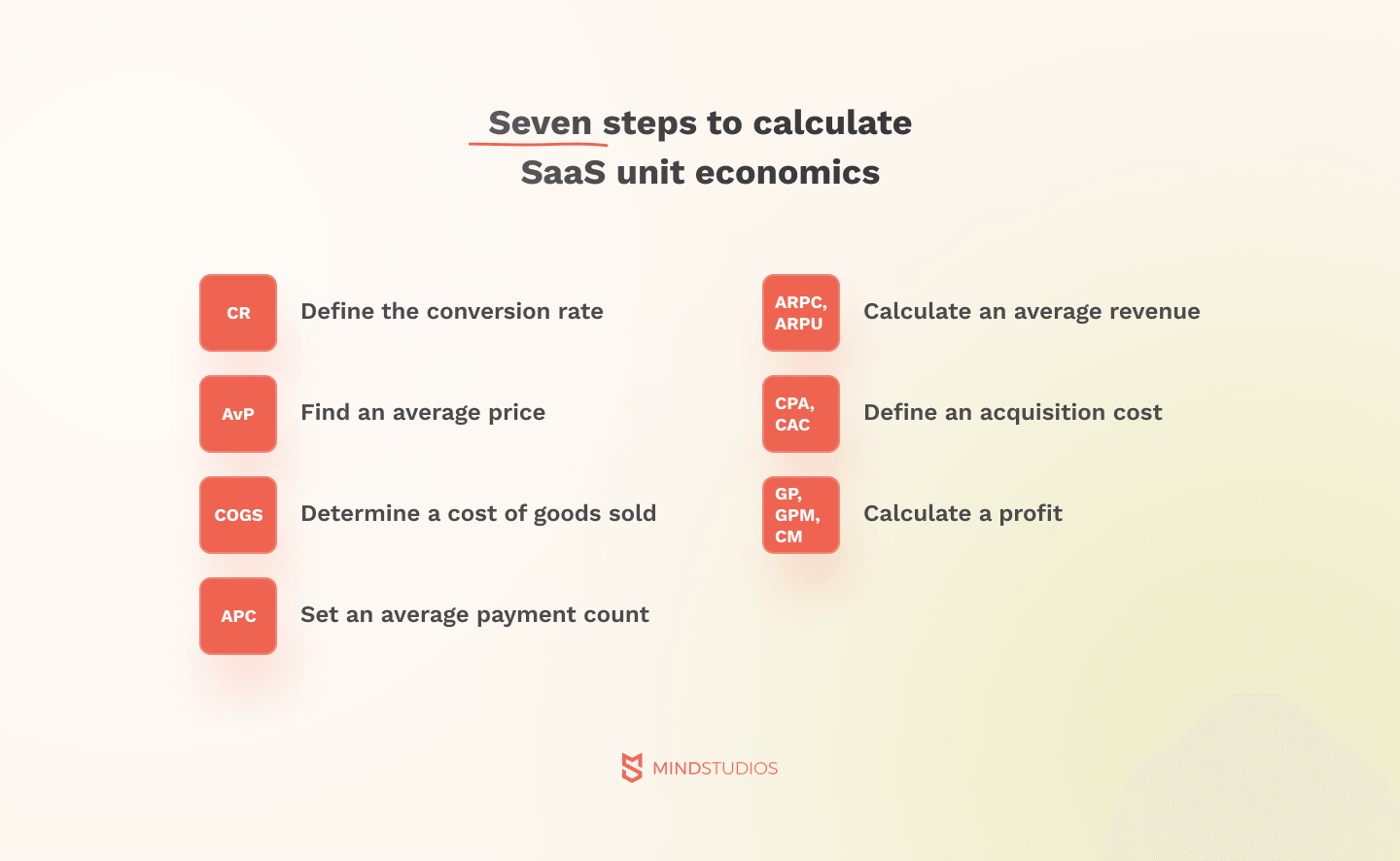
Say you’re going to develop a platform like WordPress. Your goal is to allow entrepreneurs to create websites without hiring developers. To introduce your online constructor’s capabilities, you provide users with a 14-day free trial. Then, you offer a paid subscription: $10 per month or $100 per year. So, let's look at an example of how to calculate unit economics for SaaS.
Step 1. Define the right conversion rate
Thanks to your marketing campaigns, let’s assume you attract 20,000 website visitors in the first month. This is your monthly user acquisition (UA). Out of these 20,000 visitors, 500 visitors turn into leads — those who push the button and start a free 14-day trial. In this case, you get your first conversion rate (CR1):

After trying your web constructor for free, out of 500 leads, let’s say 170 leads pay a monthly subscription and 30 leads become annual subscribers. You can calculate your second conversion rate (CR2) separately for monthly and annual subscribers or collectively:

Step 2. Find your average price
To calculate unit economics for your startup, you need to know your average price (AvP) — the arithmetic average of your customers’ payments per month:

In our example:

Step 3. Determine your cost of goods sold (COGS)
Besides calculating your average price, you should be aware of how much it costs you to deliver your online service to customers — that is, you should identify your COGS. Typically, the COGS for a SaaS platform should be between 10% to 20% of the total product price. Let’s say that it costs you $4.50 to deliver your service to a customer.
Step 4. Set your average payment count
One more metric you need to determine is the average payment count (APC), which indicates the average number of payments that one customer will make while using your software. For example, if your customers buy monthly subscriptions for 18 months on average, your APC will be 18.
Step 5. Calculate your average revenue (ARPC, ARPU)
Now let’s move to the average revenue you’ll get from a single customer within the period of using your product. This metric can be referred to as average revenue per customer (ARPC) or customer lifetime value (cLTV), but either way the approach to calculating it is the same:

In our example:

Now it’s simple to figure out how much revenue your average user (in our example, a website visitor) brings. You can calculate the average revenue per user (ARPU) or lifetime value (LTV) using the following formula:

In our example, you’ll get:

Step 6. Define your acquisition cost (marketing budget, CPA, CAC)
To calculate unit economics for startups, it’s important to know how much it will cost you to attract a single customer. To acquire 20,000 visitors to your website, you’re likely to spend a lot on:
- Paid advertising
- SEO and marketing tools
- Sales and marketing staff salaries
For example, say your user acquisition budget is $100,000 per month. Dividing this number with the total number of users that visit your website, you can figure out how much it costs you to attract one user, or your cost per acquisition (CPA):

The next step is to figure out how much it will cost you to attract one paying customer (subscriber). Change the denominator in the CPA equation to the number of customers per month to get your customer acquisition cost (CAC):

Let’s sum up the unit economics calculation for your hypothetical SaaS business. It turns out that you spend $5 to attract one website visitor and get back $3.42, and it costs you $500 to get a paying customer who gives you only $342 in payback. With CAC less than LTV, this SaaS business is loss-making.
Step 7. Calculate your profit (revenue, GP, GPM, CM)
Let’s take a closer look at metrics that refer to your startup’s revenue and profit.
Revenue (R) indicates the turnover you get from your subscription sales in a month. You can calculate it with the following formula:

Gross profit (GP) measures the effectiveness of your budget use when comparing the revenue to the cost associated with producing your product or service. It looks like this:
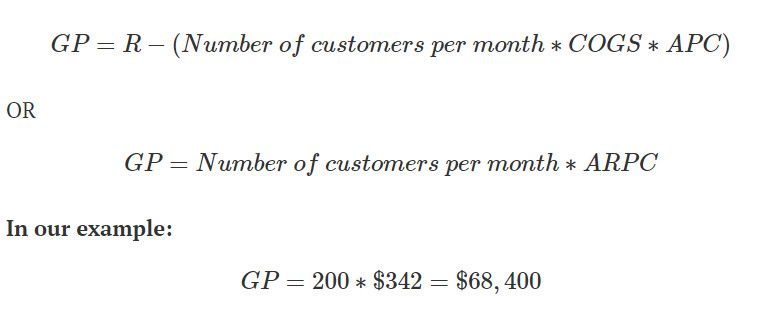
Unlike gross profit, which is a current value, gross profit margin (GPM) is gross profit as a percentage of the company’s revenue. In other words, the gross profit margin indicates how effective your company is at generating revenue from each dollar you’ve spent on production.
The equation to calculate GPM is as follows:
The contribution margin (CM) shows the effectiveness of selling your product or service on your user flow. To calculate it, multiply your user acquisition rate by the difference between the revenue you get from a single user and the cost to attract that user:

Despite your gross profit margin being high, you have a solid cash gap between the revenue you get and the amount you spend. Some companies entertain the illusion that profit from devoted customers in subsequent repeat purchases can close this gap and make their unit economics positive. Don’t get yourself into this illusion!
It’s vital — especially for newly formed businesses — to reach positive unit economics on first purchases before the budget dries out. You should be sure that your startup idea will be profitable regardless of whether someone wants to buy your product/service again or only once.
Four high-impact tactics to improve your unit economics
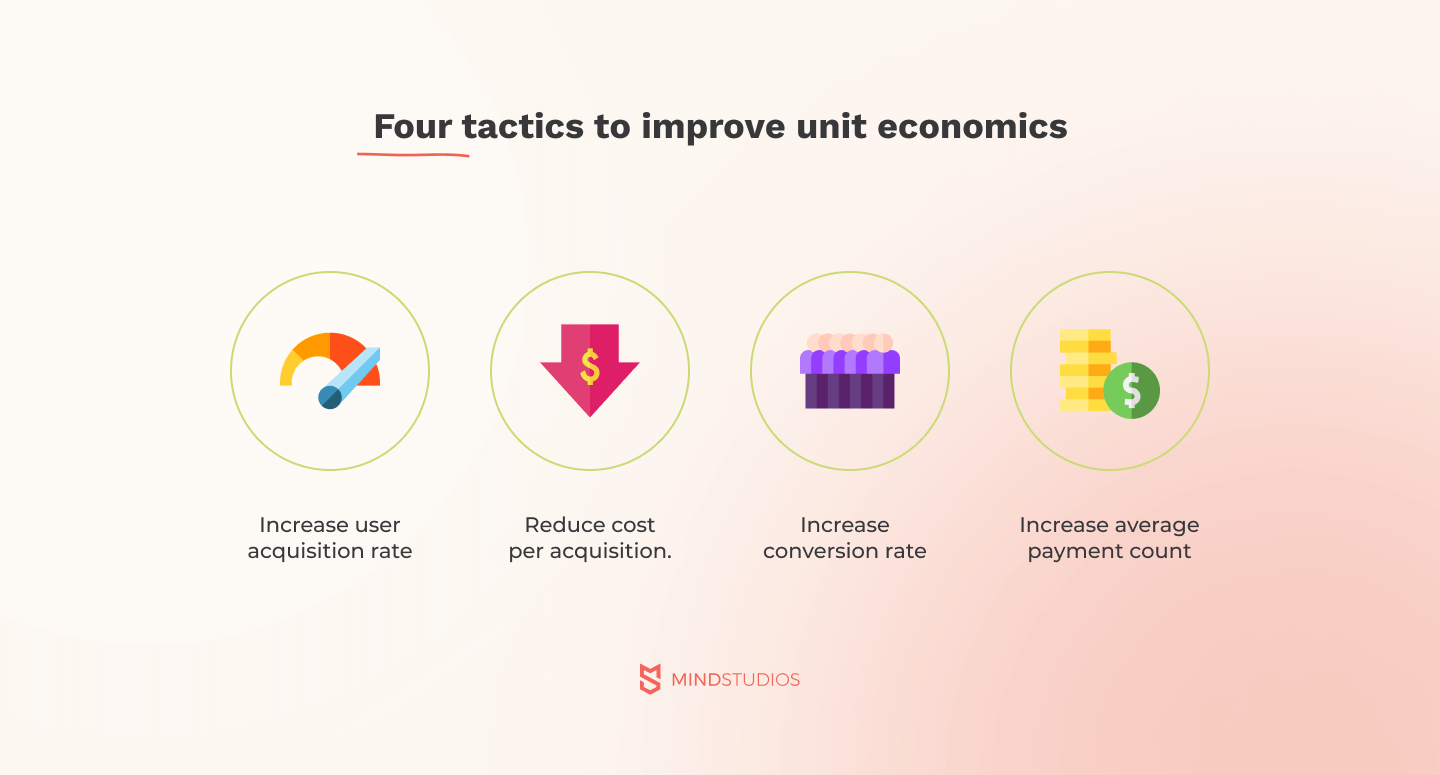
When your CAC > LTV, what can you do to reverse these metrics? First of all, you need to discover the metrics that will significantly increase your LTV or reduce your CAC if slightly changed. In most cases, improving unit economics for your tech startup is about changing four indicators: user acquisition, cost per acquisition, conversion rate, and average payment count.
- Increase user acquisition. This metric impacts your cost per acquisition: the higher your UA, the lower your CPA. If you have a low user acquisition rate, it means you have problems with marketing, advertising campaigns, and virality.
- Cut cost per acquisition. This metric impacts your contribution margin: the lower your CPA, the higher your CM. If your CPA is high, it means you use non-targeted marketing channels, face too much competition, or your communication with users is far from perfect.
- Improve your conversion rate. This is the most essential indicator of user engagement. CR increases your LTV, so the higher your CR, the more profitable your business. If users don’t understand the benefits of your offer after visiting your website, get tired of your long sales funnel, or get confused with your UX design, your conversion rate will be miserable.
- Increase average payment count. This metric shows how marketable your product or service is, how well it meets your target users’ needs, and how loyal your customers are to your brand. Your LTV is directly tied to your APC. If your APC is low, pay attention to the retention rate and how often you offer users to purchase your product (push notifications, call-to-action buttons, pop-ups, etc.).
Let’s find the optimal unit economics model for a SaaS platform using the reactive approach. Say your fixed costs on rent, utilities, salaries, and taxes are about $20,000 per month, and to cover them, you want to reach a positive contribution margin of $30,000.
As you can see, increasing user acquisition from 20,000 website visitors to 30,000, the conversion rate from 1% to 1.35%, and the average payment count from 18 to 24 payments leads to the desired contribution margin of $29,060. This contribution margin allows you to cover fixed costs and turn a loss-making business into a profitable one.
Before you dive into your startup development, it’s sensible to figure out whether you can generate the user traffic, conversion rate, cost per acquisition, marketing budget, and number of repeat purchases required to stay afloat.
To do this, our unit economics calculator can come in handy. Download it, put your values in the yellow cells, calculate your unit economics, and analyze the outputs.
To understand whether you can expand your business right now, while calculating the user traffic you need, take into account only those acquisition channels that can bring you rapid results. For example, advertising campaigns can sharply skyrocket the number of your website visitors, unlike organic traffic or referral marketing, which require more time and effort to increase your user acquisition rate.
Moving from predictive to flexible unit economics
As your business grows, you will collect more and more data about your key performance metrics. To correctly measure your profit and choose effective ways for business expansion, you need to calculate and analyze unit economics by dividing users into cohorts accounting for their retention rate and churn rate and by specifying your monthly recurring revenue.
Cohort analysis
Predictive unit economics is based on one cohort of users: the first buyers in the first month of your website operating.
But since your business develops, you’ll get:
- monthly active users
- users that buy only one time
- users that buy your product or service for some period and then quit
- users that don’t buy anything during a couple of months and then return
All these types of users generate different revenue, have unique conversion rates, and require separate calculations. Cohort analysis is a matrix that you can use to divide users into groups (for example, by month) and record what revenue they bring to you each month.
Monthly recurring revenue
For SaaS businesses, subscription types can vary, as can the size of monthly payments from customers. For example, some of your customers can move from an existing plan to a lower plan or to a higher plan and buy add-ons or cross-products in a given month.
To make your unit economics analysis more thorough, you need to define your monthly recurring revenue (MRR). It indicates the revenue from all active subscriptions along with periodic charges from discounts, add-ons, cross-selling, and coupons over a specific month.
To make a thorough unit economics analysis for an existing business, you need to take into account all types of MRR, namely:
- New MRR — First payments from new customers
- Old MRR — Recurring payments from current customers
- Expansion MRR — Extra payments driven by customers’ moving to more expensive plans
- Contraction MRR — Reduced payments due to customers’ moving to less expensive plans
- Churn MRR — Reduction in payments for a specific month
- Reactivation MRR — Renewed payments caused by the return of customers who account for churn MRR
Calculating unit economics for an existing business isn’t a cakewalk. We’ll consider it in more detail in subsequent posts.
Conclusion
If you want to conduct a meticulous analysis of your unit economics, be ready to explore lots of indicators and combine them to see the whole picture. Usually, tracking profitability in a company is a task for the chief financial officer (CFO). As for software development, unit economics is the prerogative of a product manager.
If you have any questions or you need help with bringing your website or mobile app idea to the market, feel free to contact us.




